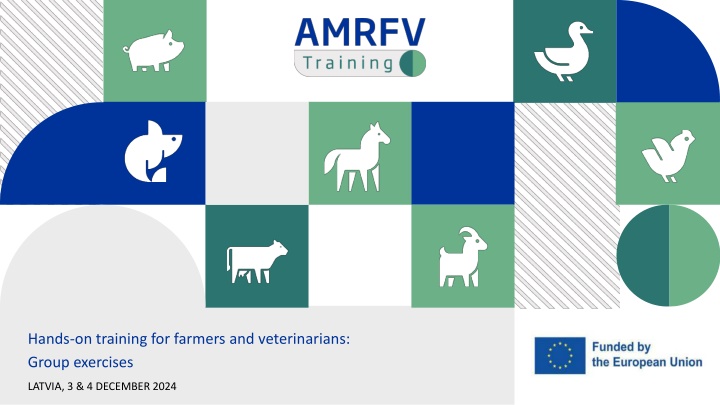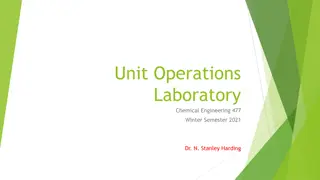
Hands-On Training for Farmers and Veterinarians in Latvia 2024
Join us in Latvia on December 3rd and 4th, 2024 for hands-on training aimed at fostering collaboration between farmers and veterinarians to reduce antimicrobial resistance. Learn about preventive measures, identify key areas for collaboration, and engage in group exercises to address challenges and find solutions. Be part of the effort to improve animal health and implement responsible antimicrobial use on farms.
Download Presentation

Please find below an Image/Link to download the presentation.
The content on the website is provided AS IS for your information and personal use only. It may not be sold, licensed, or shared on other websites without obtaining consent from the author. If you encounter any issues during the download, it is possible that the publisher has removed the file from their server.
You are allowed to download the files provided on this website for personal or commercial use, subject to the condition that they are used lawfully. All files are the property of their respective owners.
The content on the website is provided AS IS for your information and personal use only. It may not be sold, licensed, or shared on other websites without obtaining consent from the author.
E N D
Presentation Transcript
Hands-on training for farmers and veterinarians: Group exercises LATVIA, 3 & 4 DECEMBER 2024
Prevention is better than cure Part I New regulatory framework Global need: reduction Antimicrobial resistance Part II Changes at farm level: Common understanding between farmers and veterinarians Preventive measures to be implemented at farm level
Prevention is better than cure Let s work together to prevent and reduce the use of antimicrobials By creating action points on YOUR (client s) farm
Foster collaboration between farmers and veterinarians There is more and more collaboration between the farmer and the veterinarian to improve animal health and to reduce the use of antimicrobials on farm level Because it is effective! The aim for today is to identify common key areas in which farmers and veterinarians can collaborate, which leads to further improvement.
We will do the following group exercises: GE 1 Identify problems and opportunities Identify problems and opportunities Group exercise 1 to reduce and responsible use of antimicrobials husbandry practices Problems & opportunities of veterinarians identified Problems& opportunities of farmers identified Group exercise 2 Find solutions to address barriers 2 b 2 a to improve husbandry practices to reduce and responsible use of antimicrobials GE 2a Identify GE 2b Group exercise 3 Sharing, presenting outcomes 3 b GE 3a 3 a Measures to reduce and responsible use of antimicrobials List husbandry practices GE 3b
Announcement After group exercise 2a and 2b, you will be asked to write down a SMART action point for yourself to be implemented on your / your client s farm For example: By analyzing the blood and slaughter line test results and adjusting the vaccination policy accordingly, there will be no cough in weanling piglets within 2 months.
Group exercise 1 Identify problems / barriers towards implementing best practices Please, answer to the following questions: 1. What are the most used antimicrobials in your species and for which conditions? 2. Share good practices that you have implemented or planning to implement to allow a reduced use of antimicrobials Husbandry practices Reduced and responsible use of antibiotics Other 3. Name the reasons why these best practices are not easy to implement?
Examples of husbandry practices - Feeding and nutrition, - Housing and infrastructure, - Reproductive management, - Preventive management, - Welfare, - Records and documentation - Biosecurity - Hygiene - Genetics
Examples of responsible use of antimicrobials - diagnostic tests, - drug administration, - drug dosage, - alternatives to the use of antimicrobials, - monitoring and review of antimicrobial use practices, among others - pathogen identification - susceptibility testing
Group exercise 2a Find solutions to the problems & barriers identified in GE1 husbandry practices Farmers and veterinarians should be grouped together per species. Take a flip-over to answer the following questions (work with post-its) What were the problems/barriers previously identified in GE1? (focus on husbandry practices) What are the solutions to address these barriers? Create a SMART goal for yourself - to be implemented on your / your client s farm
Group exercise 2b - Find solutions to address problems & barriers from GE1 Reduced and responsible use of antimicrobials Farmers and veterinarians should be grouped together per species. Take a flip-over to answer the following questions (work with post-its) What were the barriers towards a reduced and responsible use of antimicrobials identified in GE1? What are the solutions to address these barriers? Create a SMART goal for yourself - to be implemented on your / your client s farm
Group exercise 3a: Presentation of the outcomes: solutions to improved husbandry practices Each table addresses one presenter In what way can improved husbandry practices contribute to the reduction of AMU? Each presenter presents one outcome of his/her table session Then we continue to the next table mention an outcome that haven t been mentioned before!
Group exercise 3b: Presentation of the outcomes: measures to reduce and use antimicrobials in a more responsible way Each table will be represented by one presenter. In what way can other measures to be implemented contribute to the reduction of AMU? Each presenter presents one outcome of his/her table session Then we continue to the next table mention an outcome that haven t been mentioned before!
Farmers and veterinarians working together towards a common goal




















